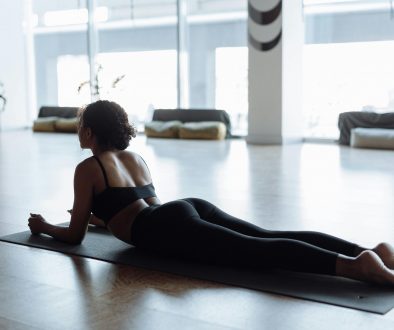How is working from home working for you?
Naomi one of our chiropractors based in our Cheltenham clinic talks about working from home.
Over the past 18 months, many of us have had to adapt to working from home and for a large number of people, this is now “the new normal” and routine that seems to be around for a while to come.
During this time, I have heard frequently that people have begun to experience increased back and neck pain over this period. Therefore, I have come up with some top tips to help lead a pain-free work life.
Desk Set up
It may seem simple but how much do you think about the way in which your desk is set up?
Chair
Your chair should be set to a height so your elbows can comfortably rest on the desk at a 90° bend and your feet placed flat on the floor whilst also aiming to keep your knees bent at roughly 90°. You may find it helpful to rest your feet on a step to accomplish this and to keep your hips very slightly higher than your knees.
It is important you choose a supportive chair with good lumbar support that is correctly adjusted. The lowest edge of lumbar support should be placed at your belt line and then the depth adjusted until it comfortably fills the arch of your back and helps maintain your spine’s natural ‘S’ shape.
Alternatives to a traditional office chair may also be worth consideration:
- Exercise ball
- Kneeling chair
- Standing desk (or height adjustable desk) – no chair at all!
- NOT your sofa, bed, or floor!
Keyboard and Mouse
Your keyboard and mouse should be positioned directly in front of you with your wrists and forearms neutrally relaxed on the desk. Think about keeping your wrists in line with your forearm and trying not to extend them into a backward position. Using a laptop trackpad promotes an unnatural posture for your arms and wrists, therefore, it may be a good idea to consider getting a separate mouse.
Monitor
Your monitor should again be placed directly in front of you at about an arm’s length distance (roughly 50-60cm away). The height should be adjusted so the top third of the screen is in direct eye line, you may find using chunky books or a good laptop stand can help achieve this.
Regular Breaks
Something I hear regularly from people adapting to working from home is that they got up from their desk or had more regular breaks when working in the office. Whether it was going to the toilet, discussing a situation with a colleague, or getting the tea and coffee. Whereas at home, they find they give themselves less opportunity to get up from their workspace.
We would recommend getting up every 20-30 minutes to give your muscles a chance to relax whilst others can move and become a bit more active. Even if this means standing up at your desk and marching on the spot for a minute or two, little and often is preferred as opposed to fewer breaks for longer. Sitting for long periods of time will increase the pressure through the spine and can result in posture related pain.
Try not to sit in the same position for too long and try to change your posture often, a height adjustable desk can come in particularly handy with this. Using a timer is useful to help you remember not to stay in the same position for too long.
Postural exercises at your desk
Simple stretches and exercises you can perform at your desk can also help relieve some of the pressures going through your body. They can be particularly useful if you are very busy with work or working for a deadline and unable to take frequent breaks.
Chin Tucks
- Sit up tall in your chair and focus your gaze on something in direct eye line
- Slowly tuck your chin backward and further pull your head up as if there was a piece of string pulling the back of your head upwards
- Hold this position for 12-15 seconds and repeat 3 time
Upper Trap Stretch
- Whilst sitting on your chair anchor one hand under your seat to depress the shoulder
- Tilt your head away from this shoulder and turn your head so your gaze is upwards
- With your free hand, hold over your head and over-pressure until you feel a stretch across the side of your neck down to your shoulder
- Hold this stretch for 20-30 seconds and perform on both sides
Brugger’s Relief
- Bring yourself forwards to the edge of your chair
- Separate your feet on the floor to just over hip width apart with your feet slightly turned outwards
- Extend your elbows and bring your arms out to the side with your palms facing up
- Open up your chest by rolling your shoulders backward and bringing your shoulder blades together
- Hold your head high and focus on tucking your chin in
Keep this position whilst you perform deep belly breathing for 20-30 seconds
If you are struggling with neck, upper back and or shoulder pain. We could be able to help you at Skelian Chiropractic clinic in Cheltenham. You can give the clinic a call on 01242 254000 or book online to see one of our chiropractors or massage therapists.
References:
NHS – How to sit at your desk correctly:
https://www.nhs.uk/live-well/healthy-body/how-to-sit-correctly/
Health and Safety Executive – Working safely with display screen equipment:
https://www.hse.gov.uk/msd/dse/work-routine.htm
Links:
https://www.instagram.com/skelian_chiropractic/
https://www.facebook.com/skelianclinic/
https://www.youtube.com/channel/UCCJ9BXYUAAfOie7zTUUeIKA/videos





